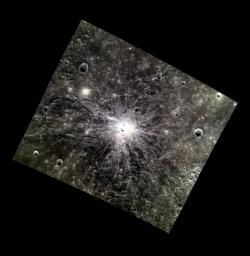
|
Fade To Black
- Click the image above for a larger view
- Full-Res JPEG (1448 x 1481) (191.0 kB)
- Full-Res TIFF (1448 x 1481) (6.4 MB)
Caption:
Today's image features an unnamed crater located north of the crater Couperin. Although this crater is only about 6 km (3.7 mi.) in diameter, its bright rays cause it to stand out prominently in regional views of the planet. The rays are particularly distinctive because they fade into the blacker background of low reflectance material .
This image was acquired as a targeted high-resolution 11-color image set. Acquiring 11-color targets is a new campaign that began in March 2013 and that utilizes all of the WAC's 11 narrow-band color filters. Because of the large data volume involved, only features of special scientific interest are targeted for imaging in all 11 colors.
Date acquired:
October 19, 2013
Image Mission Elapsed Time (MET):
24470528, 24470520, 24470516
Image ID:
5033545, 5033543, 5033542
Instrument:
Wide Angle Camera (WAC) of the Mercury Dual Imaging System (MDIS)
WAC filters:
9, 7, 6 (996, 748, 433 nanometers) in red, green, and blue
Center Latitude:
35.86°
Center Longitude:
207.9° E
Resolution:
207 meters/pixel
Scale:
This image is roughly 285 km (177 mi.) from corner to corner diagonally.
Incidence Angle:
37.1°
Emission Angle:
9.1°
Phase Angle:
41.6°
Background Info:
The MESSENGER spacecraft is the first ever to orbit the planet Mercury, and the spacecraft's seven scientific instruments and radio science investigation are unraveling the history and evolution of the Solar System's innermost planet. MESSENGER acquired over 150,000 images and extensive other data sets. MESSENGER is capable of continuing orbital operations until early 2015.
For information regarding the use of images, see the MESSENGER image use policy .
Cataloging Keywords:
| Name | Value | Additional Values |
|---|---|---|
| Target | Mercury | |
| System | ||
| Target Type | Planet | |
| Mission | MESSENGER | |
| Instrument Host | MESSENGER | |
| Host Type | Orbiter | |
| Instrument | Mercury Dual Imaging System (MDIS) | |
| Detector | Wide Angle Camera (WAC) | |
| Extra Keywords | Color, Crater, Radio | |
| Acquisition Date | ||
| Release Date | 2013-11-11 | |
| Date in Caption | 2013-10-19 | |
| Image Credit | NASA/Johns Hopkins University Applied Physics Laboratory/Carnegie Institution of Washington | |
| Source | photojournal.jpl.nasa.gov/catalog/PIA17678 | |
| Identifier | PIA17678 | |
